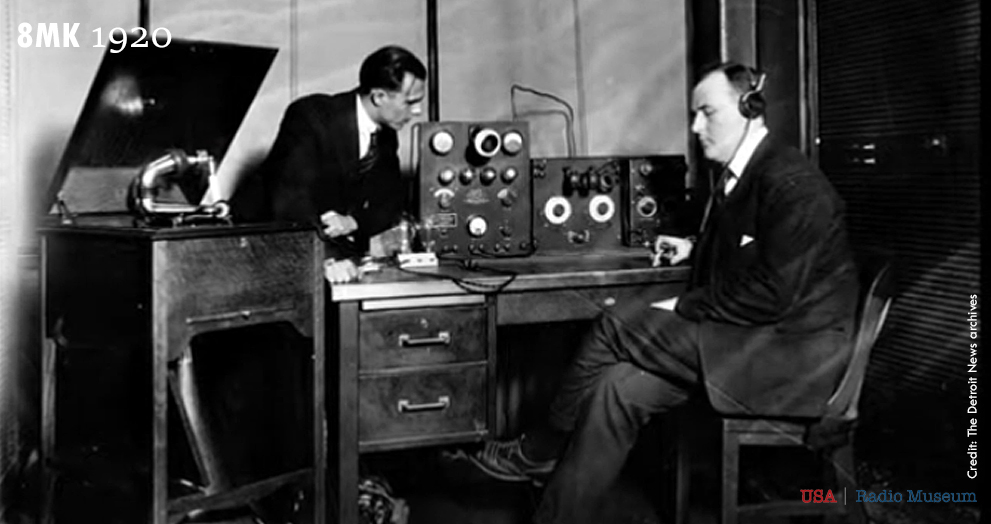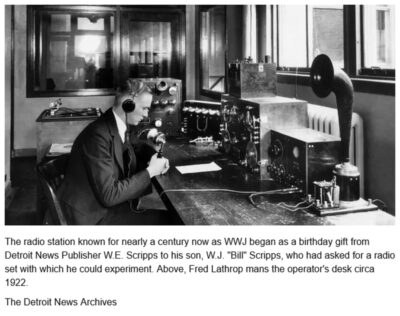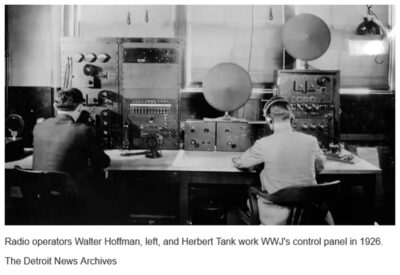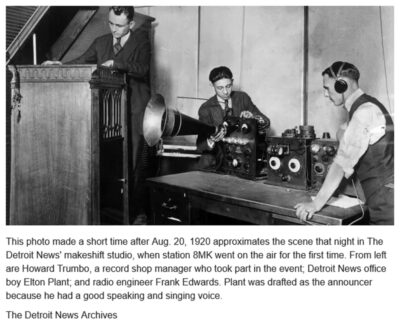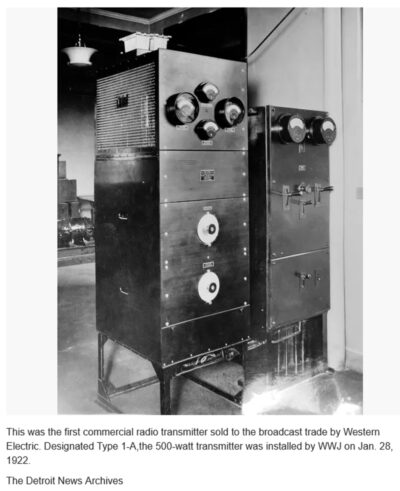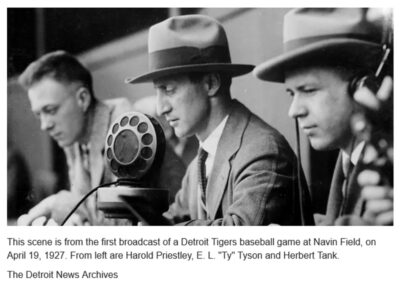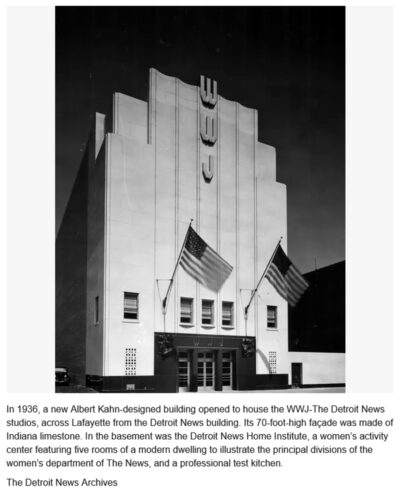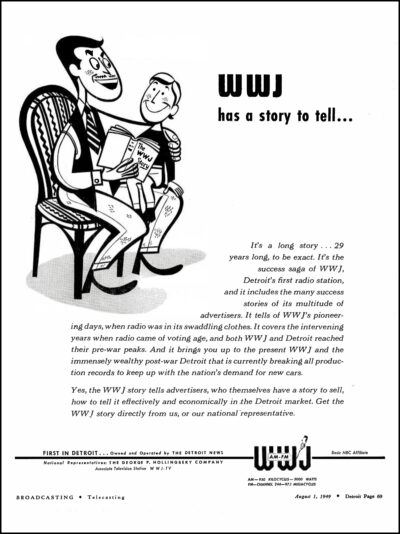Live from Detroit: The First Voice of American Radio Before the Broadcast: A City Poised for the Air Detroit, 1920. The city echoed with
Live from Detroit: The First Voice of American Radio
Before the Broadcast: A City Poised for the Air
Detroit, 1920. The city echoed with the rhythm of progress—steam whistles from the factories, Model T’s sputtering down dusty streets, newsboys shouting headlines on Jefferson Avenue. But upstairs in the Detroit News Building, another kind of machinery was humming to life. One not powered by gasoline or gears, but by curiosity—and copper wire.
On August 20, 1920, in a moment that would change the world, a voice crackled across invisible airwaves:
“This is 8MK calling. The Detroit News Radiophone.”
Unpolished, experimental, and barely reaching past city limits, this was the first scheduled radio broadcast in history. Before the BBC. Before KDKA. Before the world knew what “radio” could become—Detroit was already speaking.
The station was 8MK. The mission? To tell stories with sound. And from that night forward, the age of broadcast was born.
The Scripps Vision: From Ink to Air
The voice behind the mic was no lone inventor—it was the product of journalistic innovation. The Detroit News, under publisher George Gough Booth, saw radio not as a novelty, but as the next evolution of the press.
Newspaper circulation was booming, but Booth recognized radio’s potential to deliver instantaneous information, especially as postwar America entered an era of rapid technological advancement. Working with radio pioneer Michael DeLisle Lyons and editor Malcolm Bingay, The News quietly constructed a modest 100-watt transmitter using surplus military parts. They strung a 200-foot antenna between two downtown buildings and secured a license from the Department of Commerce.
What followed was more than an experiment—it was an act of journalistic courage. On that warm August evening, they broadcast weather, election updates, and phonograph music in real time—establishing the first template for modern radio.
Within days, reception reports flooded in. One came from New York. Radio’s reach had exceeded its creator’s expectations—and so had its power.
From 8MK to WWJ: A Legacy in Call Letters
In 1922, the call sign 8MK was officially replaced by WWJ, in compliance with new federal licensing requirements. Legend holds the new call letters honored Booth’s son, William John, though no record confirms it. Either way, WWJ became synonymous with American broadcast history.
Under the WWJ call, the station flourished:
- First religious service broadcast in 1921
- First symphony concert from Orchestra Hall in 1922
- First Detroit Tigers game aired in 1927 by Ty Tyson
For decades, WWJ wasn’t simply a broadcaster. It was a public utility of sound—delivering headlines, culture, and community over the air. The Scripps family never commercialized it heavily, operating it instead as a gift to Detroit, tethered to the conscience of the newspaper that bore it.
In fact, by 1928, The Detroit News had reportedly invested over $466,000 in the station without seeking profit—a staggering sum in the pre-Depression economy.
WWJ had become the newsprint’s voice. And it never looked back.
The Power of Local Sound
Throughout the 1930s and ’40s, WWJ’s antenna rose alongside Detroit’s skyline. The station expanded staff, built new studios at 600 West Lafayette, and cemented its reputation for credible, reliable journalism.
During WWII, it didn’t just report from overseas—it mobilized Detroiters at home with blood drive announcements, rationing campaigns, and war bond promotions. It aired neighborhood poetry contests, civic debates, and gospel concerts from Black Bottom. In every sense, WWJ was a community forum powered by airwaves.
And when the television revolution dawned, WWJ adapted once again—launching Michigan’s first TV station in 1947, WWJ-TV (now WDIV).
Radio’s golden age may have been giving way to new forms, but WWJ’s microphone never went silent moving forward.
24-Hour News and a New Identity
The 1970s ushered in change. FM music stations dominated the dial, and Detroit’s AM landscape was crowded with personality-driven shows and emerging talk formats. WWJ, sensing the shift, pivoted.
In 1971, it adopted a 24-hour all-news format, a bold but prophetic move. Anchored by its CBS network affiliation, the station launched a steady rhythm: news updates, weather, traffic “on the 8s,” sports, and market reports—around the clock, every day.
That model remains its trademark more than 50 years later.
WWJ Newsradio 950 became not just a source, but a companion—through blizzards, freeway shutdowns, elections, parades, Red Wings playoff runs, and breaking events that shook the nation.
From local anchor desks, the voices of Detroit guided listeners minute by minute through a changing world.
A Fork in the Signal: The End of a Historic Ownership
For 65 years, WWJ operated under the careful stewardship of The Detroit News and the Scripps family, who saw radio not as a profit engine but as a journalistic extension of the printed word. Since its birth as 8MK in 1920, the station had been treated as a civic service—staffed, funded, and protected by one of the country’s most forward-thinking newspaper publishers.
Even into the 1980s, WWJ maintained its news-first identity, resisting the lure of tabloid talk and sensationalism that had begun to reshape AM radio. But as the media business evolved—with rising costs, increased FCC scrutiny, and industry-wide consolidation—so did the economics of owning both a newspaper and a broadcast outlet.
In 1985, a turning point arrived. The Scripps family sold The Detroit News to Gannett Company, and as part of the transition, WWJ-AM and its FM sister station WJOI were spun off and sold separately to a consortium of Detroit-area businessmen. It was the first time in the station’s history that it operated outside the newspaper’s direct ownership.
“The station had outgrown the paper’s ability to support it in a changing media world,” one executive reflected at the time.
Though symbolic of a shifting era, the change in ownership did not sever WWJ’s core mission. The station continued to evolve under new leadership, eventually being acquired by CBS Radio, which brought broader network integration and access to national reporting. In 2017, CBS Radio merged with Entercom, which later rebranded as Audacy, Inc., WWJ’s current parent company.
Ownership changed. Studio walls were painted. Transmitters modernized. But the spirit of 8MK still coursed through WWJ’s signal—steady, reliable, and rooted in service.
The Centennial and Beyond
In 2020, WWJ celebrated its 100th anniversary—an almost unfathomable milestone in an industry built on transience. Its centennial programming included archival replays, oral histories, and glowing tributes to the station’s most legendary voices.
Few institutions can claim to have informed five generations of a city. Fewer still can trace their history back to the first-ever scheduled broadcast. But WWJ can—and does.
That legacy continues daily from studios in Southfield, where editors still script hourly rundowns, reporters still chase down local leads, and Detroiters still tune in to hear “Newsradio 950” say what’s happening next.
Epilogue: A Signal Through Time
WWJ’s story is more than a tale of watts and microphones. It’s a reflection of Detroit itself—gritty, inventive, resilient.
It was never merely about headlines. It was about making sense of them together—through shared sound. It was about giving a region a voice, day after day, even when the rest of the world seemed too loud to hear.
WWJ didn’t predict the future. It became part of it.
And it all began with seven words:
“This is 8MK calling. The Detroit News Radiophone.”
_____________________
A Sidebar: From Pressroom to Airwaves—And Beyond
The Detroit News and WWJ: A 65-Year Partnership That Shaped Broadcast History
1920 – The Birth of 8MK
The Detroit News, owned by the Scripps family, launches 8MK on August 20, 1920. It becomes the first radio station in the world to broadcast scheduled news and music programming. The station is operated as a public service, not a commercial venture.
1922 – 8MK Becomes WWJ
On March 3, 1922, the station is relicensed as WWJ. The call letters are said to honor William E. Scripps and his son William J. Scripps. The station remains under the direct ownership and editorial guidance of The Detroit News.
1920s–1950s – A Mission Over Money
WWJ operates without commercial advertising for many years. By 1928, The Detroit News had invested nearly $466,000 into the station—an enormous sum at the time—without seeking profit. The paper viewed radio as an extension of its journalistic mission, not a revenue stream.
1936 – A Home of Its Own
WWJ moves into its own purpose-built broadcast facility at 600 West Lafayette Boulevard, just across from The Detroit News building. The station continues to innovate, becoming the first in Michigan to broadcast sports, symphonies, and national election returns.
1970s–1980s – Changing Times, Changing Media
As the media landscape shifts—with the rise of FM radio, television, and corporate consolidation—newspapers face increasing pressure to divest non-core assets. WWJ, though still respected, is no longer financially sustainable under the newspaper’s ownership model.
1985 – The End of an Era
After 65 years, The Detroit News is sold by the Scripps family to Gannett Company. As part of the deal, WWJ (AM) and its FM sister station WJOI are spun off and sold to a group of Detroit-area investors. This marks the first time WWJ is no longer under the stewardship of the newspaper that created it.
“It was a difficult but necessary decision,” one executive reportedly said at the time. “The station had outgrown the paper’s ability to support it in a changing media world.”
Post-1985 – A New Chapter
WWJ is later acquired by CBS Radio, aligning it with a national network of powerhouse stations. In 2017, CBS Radio merges with Entercom, which rebrands as Audacy, Inc. WWJ remains a CBS News Radio affiliate, continuing its all-news format as WWJ Newsradio 950.
Today – Still Detroit’s Voice
Though no longer owned by The Detroit News, WWJ continues to honor its roots—delivering trusted, around-the-clock news to Metro Detroit. Its DNA remains unmistakably journalistic, a living legacy of the newspaper that dared to speak through the air.
_____________________
A USARM Viewing Tip: On your mobile or tablet device? Finger-tap all the above images inside the post and stretch image across your device’s screen for LARGEST digitized view.

